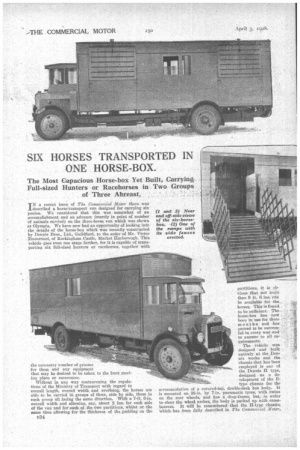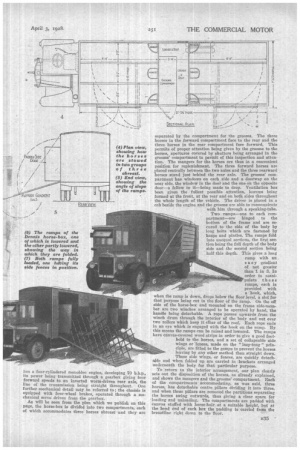SIX HORSES TRANSPORTED IN ONE HORSE-BOX.
Page 68

Page 69

If you've noticed an error in this article please click here to report it so we can fix it.
The Most Capacious Horse-box Yet Built, Carrying Full-sized Hunters or Racehorses in Two Groups • of Three Abreast.
IN a recent issue of The Commercial Motor there was described a horse-transport van designed for carrying six ponies. We considered that this was somewhat of an accomplishment and an advance (merely in point of number of animals carried) on the three-horse van which was shown at Olympia. We have now had an opportunity of looking into the details of the horse-box which was recently constructed by Dennis Bros., Ltd., Guildford, to the order of Mr. Victor Emmanuel, of Rockingham Castle, Market Harborough. This vehicle goes even one stage farther, for it is capable of transporting six full-sized hunters or racehorses, together with
the necessary number of grooms for them and any equipment that may be desired to be taken to the hunt meeting place or racecourse.
Without in any way contravening the regulations of the Ministry of Transport with regard to overall length, overall width and overhang, the horses are able to be carried in groups of three, side by side, those in each group all facing the same direction. With a 7-ft. 6-in. overall width and allowing, say, about 2 ins, for each side of the van and for each of the two partitions, whilst at the same time allowing for the thickness of the_padding on the Is34
partitions, it is obvious that not more than 6 ft. 6 ins. can be available for the.. horses. This is found to be sufficient. The horse-box has now been in use for three monthsand has. proved to be successful in every way .and to answer to all requirements.
The vehicle was designed and built entirely at the Dennis works and thechassis that has been employed is one of the Dennis II type, designed as a development of the Etype chassis for the accommodation of a covered-ton, double-deck bus body. It is mounted on 38-in. by 7-in, pneumatic tyres, with .twins on the rear wheels, and has a, drop-frame, but, in order to clear the wheel arches, the body is packed up with crossbearers. It will be remembered that the fl-type ebassis, whichhas. been fully described in The Commercial Motor, has a four-cylindered monobloc engine, developing 70 b.h.p., its power being transmitted through a gearbox giving four forward speeds to an inverted worm-driven rear axle, the line of the transmission being straight throughout. One further mechanical detail may be referred to; • the chaisis is equipped with four-wheel brakes, operated through a mechanical servo driven from the gearbox.
As will be seen from the plan which we publish on this page, the horse-box is divided into two compartments, each of which accommodates three horses abreast and they are separated by the compartment for the grooms. The three horses in the forward compartment face to the rear and the three horses in the rear compartment face forward. This permits of proper attention being given by the grooms to the horses, apertures covered by shatters being arranged in the grooms' compartment to permit of this inspection and attention. The mangers for the horses are thus in a convenient position for replenishment. The three forward horses are placed centrally between the two axles and the three rearward horses stand just behind the rear axle. The grooms' compartment has windows on each side and a doorway on the near side, the window in the door and the one on the opposite door—a fellow to it—being made to drop. Ventilation has been given the fullest possible attention, louvres being formed at the front, at the rear and on both sides throughout the whole length of the vehicle. The driver is placed in a cab beside the engine and the grooms are able to communicate with him through a speaking-tube.
Two ramps—one to each compartment—are hinged to the botfom of the frame and •are secured to the side of the body by long bolts which are fastened by hasps and pintles. The ramps fold into unequal sections, the first section being the full depth of the body side and the second section being half this depth. This gives a long ramp with. an easy gradient of not greater than 1 in 3. In order to manipulate these ramps, each is provided with a hook, which, when the ramp is down, drops below the floor level, a slot for that purpose being cut in the floor of the ramp. On the off side of the horse-box and mounted on the frame side-member are two winches arranged to be operated bY hand, the handle being detachable. A rope passes upwards from the winch drum through the interior of the body and out over two rollers which keep it crear of the roof. Each rope ends in an eye which is engaged with the hook on the ramp. By this means the ramps can be raised and lowered. The ramps have canvas-covered wood strips in order to give a good foothold to the horses, and a set of collapsable side wings or 'fences, made on the "lazy-tong"
are fitted to the ramps to prevent the horses leaving by any other method than straight down. These side wings, or fences, are quickly detachable and when folded up are carried in brackets arranged underneath the body for that particular purpose.
To return to the interior arrangement, our plan clearly Sets out the disposition of the horses, as already explained, and shows the mangers and the grooms' compartment. Each of the compartments accommodating, as was said, three horses, has detachable centre pillars dividing it into three, and when these pillars are removed the partitions separating the horses swing outwards, thus giving a clear space for loading and unloading. The compartments are padded with canvas stuffed with horse-hair at a suitable height, but at the head end of each box the padding is carried from the breastane right down to the floor.




















































































































